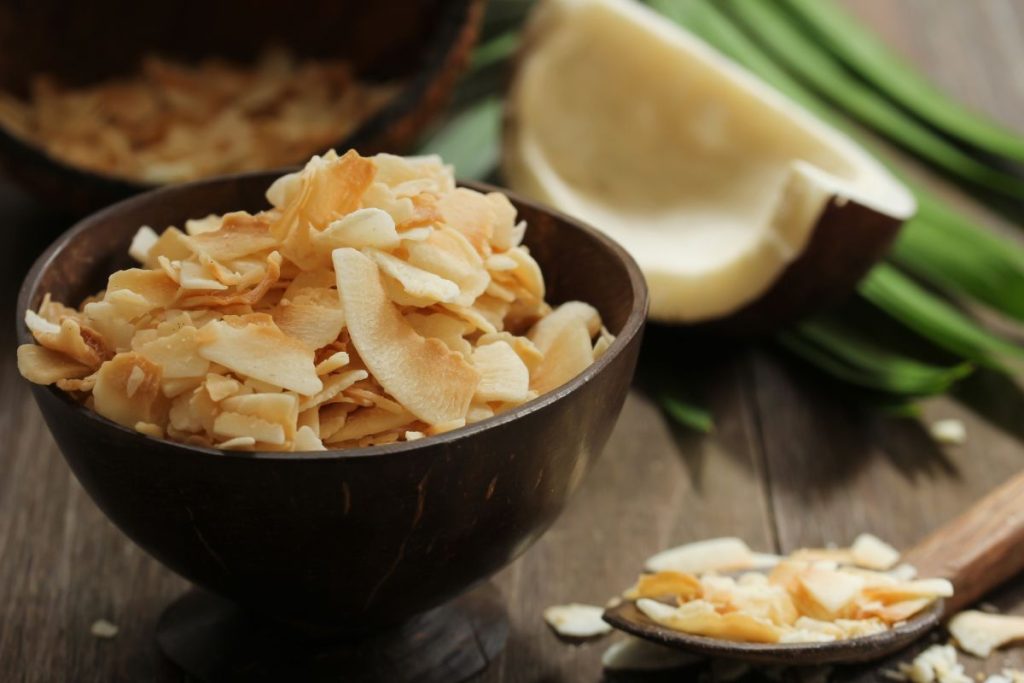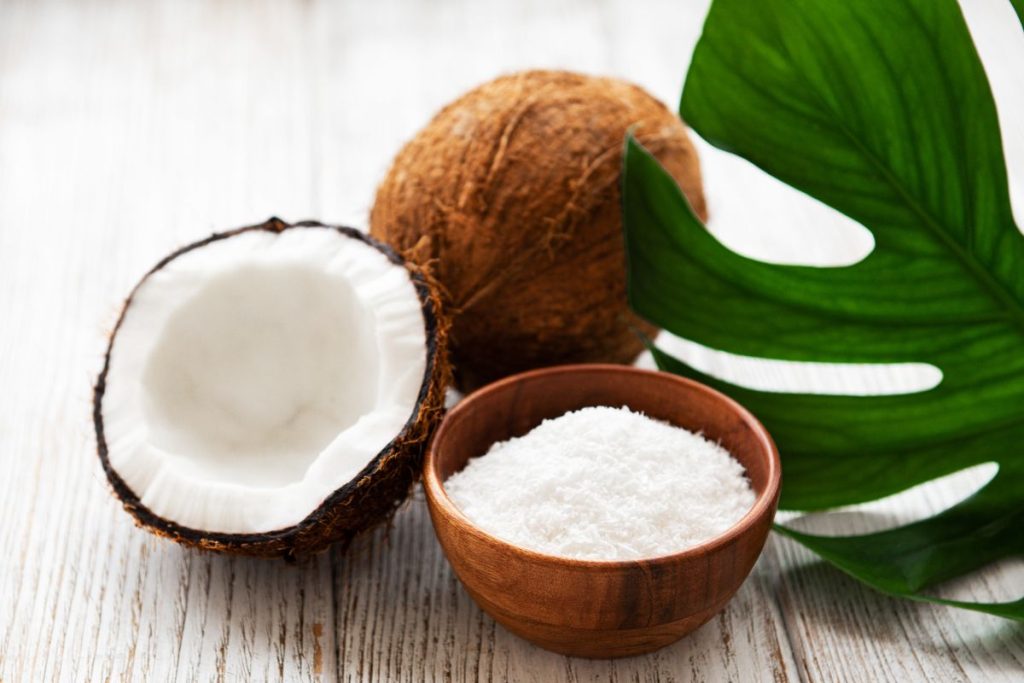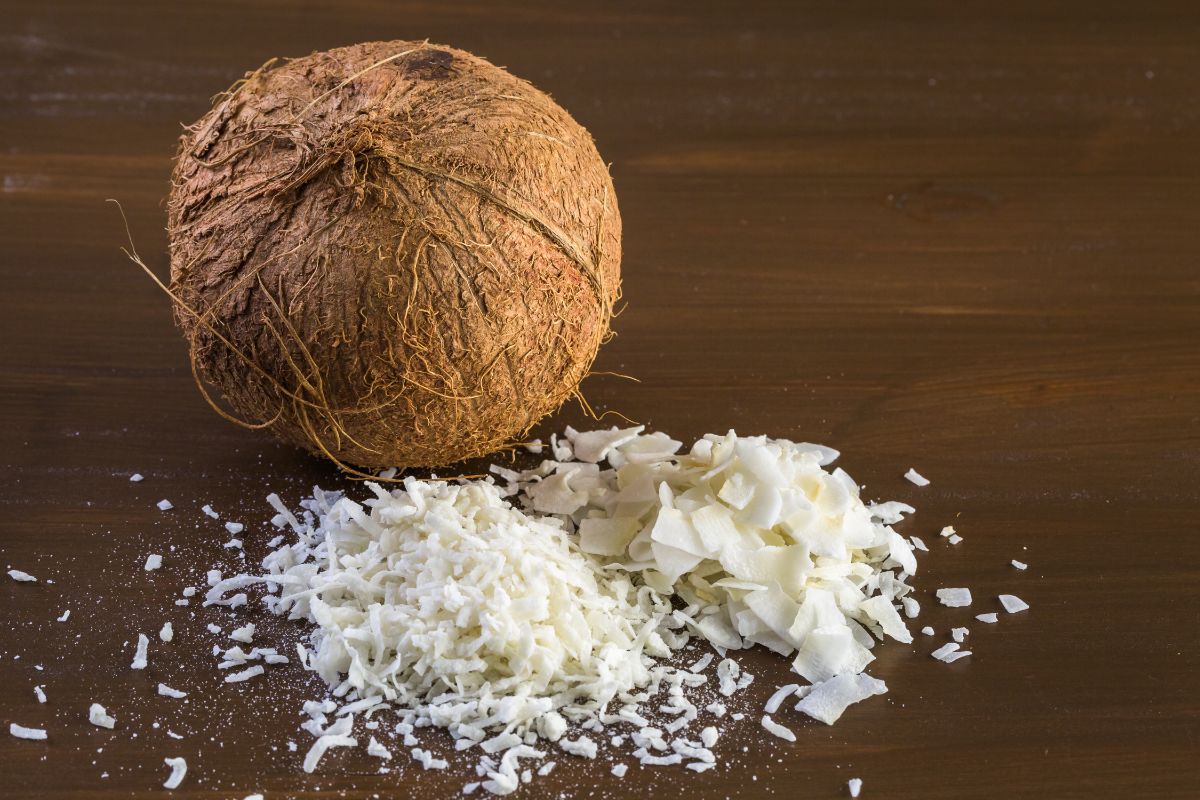To dehydrate coconut, set the food dehydrator to 130°F. Remove the meat from fresh coconuts using a coconut scraper or a knife. Cut the coconut meat into chunks or grate it into coconut flakes. Spread the coconut pieces on dehydrator trays and dehydrate them for 8–12 hours.
Table of Contents
What is the Best Way to Dehydrate Coconut?
The best method to dehydrate coconut is by using a food dehydrator. This method allows for even and consistent drying without the risk of burning the coconut.
Preparing and Dehydrating Coconut in a Food Dehydrator
- Crack open a fresh coconut using a coconut cracker or similar tool.
- Pour coconut water out into a bowl and set aside; use this to make coconut milk, coconut cream, or coconut ice cream, if desired.
- Remove the white flesh from the coconut shell using a spoon or a knife, clearing all the traces of coconut flesh from the inside of the shell.
- Rinse the coconut flesh in cold water to remove the husk remnants.
- Pat the coconut meat with a clean towel to remove excess moisture.
- Peel the brown skin from the coconut flesh using a vegetable peeler or a sharp knife.
- Chop the coconut flesh into small pieces, thin strips, or use a grater to make coconut shreds. The shape and size of the coconut pieces are an individual preference, but thicker pieces take longer to dehydrate.
- Arrange the coconut pieces on food dehydrator trays, making sure they don’t overlap or touch. If desired, sprinkle the coconut pieces with cinnamon, sugar, or spices at this point to add flavor.
- Set the food dehydrator temperature to 135°F or use the “fruit setting”.
- Let the coconut dry for 8 to 12 hours until the pieces are fully dehydrated and brittle.
- Remove the coconut pieces from the dehydrator and cool them completely at room temperature.
- Store the dried coconut in airtight containers in a cool, dry place for up to six months.

How to Dehydrate Shredded Coconut in an Oven
To make shredded coconut, use a food processor or a grater and shred the fresh coconut into uniform slivers.
Dehydrating shredded coconut takes only a few hours in an oven:
- Place shredded coconut on a baking sheet lined with parchment paper and spread it evenly in a thin layer.
- For sweetened coconut, sprinkle with a small amount of white sugar, or leave it as is for unsweetened coconut.
- Preheat the oven to 200 degrees Fahrenheit.
- Place the baking sheet inside the oven, and leave the oven door propped open a few inches to promote airflow.
- Let the coconut dry for 2-3 hours. Stir the coconut flakes from time to time to ensure even drying and avoid oven hot spots.
- Once the shredded coconut is properly dehydrated and crispy to the touch, remove it from the oven and let it cool completely at room temperature.
- Once dried, place the shredded coconut in an airtight container and store in a cool, dry place for up to six months.

Can You Dehydrate Coconut Flour?
Coconut flour is made by grinding dry coconut meat into a fine powder. Coconut flour is already dry, so it’s not necessary to dehydrate it again. If you try dehydrating coconut flour, it may clump together and become dense and hard.
Just like desiccated coconut, coconut flour should be stored in an airtight container in a cool, dry place for use within six months.

Is Dehydrated Coconut Good For You?
Like other dried foods, dehydrated coconut should be consumed in moderation as part of a balanced diet. It is a keto-friendly food with great nutritional value.
Here are some of the nutrients and health benefits of dried coconut:
- Dehydrated coconut contains high levels of dietary fiber, which is important for preventing constipation and maintaining good digestive health.
- Coconut contains healthy fats such as medium-chain triglycerides (MCTs). This type of fat helps promote weight loss and boosts metabolism.
- Dehydrated coconut is a great source of vitamins and minerals, including iron, potassium, zinc, and magnesium.
- Dried coconut is gluten-free, making it ideal for those with gluten intolerance.
- Dehydrated coconut is a healthier snack compared to other dried fruits because it contains relatively low sugar.
Dehydrated Coconut Recipe Ideas
Dehydrated coconut is highly versatile and can be used in both sweet and savory dishes. It can be added to smoothies, cereals, and baked goods for texture and a boost of tropical flavor.
Here are some delicious coconut recipes to try:
- Coconut Carrot Cake Cupcakes
- Coconut Chip Chocolate Cookies
- Coconut Milk from Dried Coconut
- Coconut Tarts
- No-Bake Coconut Balls

Best Way to Store Dehydrated Coconut
Follow these tips to keep dehydrated coconut fresh and maximize shelf life:
- Avoid storing dehydrated coconut in the refrigerator or freezer to prevent condensation.
- Dehydrated coconut lasts up to six months if properly stored.
- Keep dried coconut containers in a cool, dry environment, such as a pantry or cupboard.
- Label and date your storage container with the date you dehydrated the coconut.
- Make sure the coconut is completely dehydrated before storing it.
- Store dried coconut in an airtight container to prevent exposure to moisture and oxygen.

